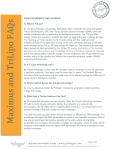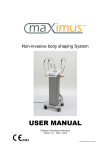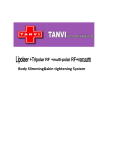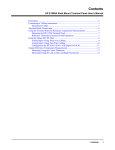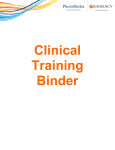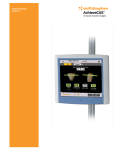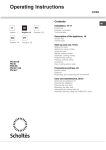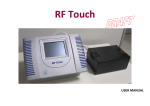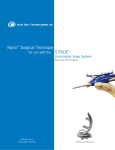Download Maximus FAQ
Transcript
FAQS FOR WEBSITE AND PATIENTS Q: What is TriFractional technology? TriFractional FAQs A: TriFractional technology is an advanced radiofrequency (RF) technology which enables fractional skin resurfacing and the treatment of wrinkles. TriFractional RF energy is delivered to the skin in a fractional manner via an array of multi-electrode pins. TriFractional RF creates micro-impact areas in the epidermis which are in direct contact with the electrodes and delivers deep heat into the mid-dermis. This leaves healthy skin between the tiny treated areas which serve as a reservoir of healthy cells to promote faster, more effective wound healing. In the epidermis, the tiny treated areas develop tiny crusts which are then shed off the skin after a few days, leading to mild epidermal resurfacing. In the dermis, treatment induces remodeling of dermal collagen (neocollagenesis), leading to smoother skin. TriFractional treatment has no down time and enables safe, tolerable and effective skin rejuvenation. Q: Is TriFractional technology safe? A: TriFractional technology is very safe when used according to the treatment guidelines. RF has been used in medicine for over 75 years and in the aesthetic industry for over ten years. The energy levels used for treatment are very effective and safe with no risk of damage to skin. Q: Which medical device has TriFractional technology? A: Only the Maximus system by Pollogen includes the proprietary TriFractional technology. Q. What should a patient expect from a TriFractional treatment? A: Before TriFractional treatments, the medical practitioner may apply a numbing cream on areas to be treated. The practitioner will then thoroughly clean the face. When the area is completely dry, the practitioner will perform a few pulses of TriFractional energy on a small area and evaluate the skin’s response, you may feel a short stinging sensation when the TriFractional energy is emitted. After the treatment, the practitioner will instruct you regarding any post-treatment care. Essentially, you should apply sunscreen and avoid the exposure to sun! You can use your regular make up and moisturizers one day after the treatment. In 2-3 days you will notice a matrix of tiny pinpoint crusted areas. The tiny crusts will naturally and gently peel off during the following days. You can apply makeup to cover the area and you should avoid rubbing or peeling the crusts. After about a week you will August 2011 notice an improvement in skin texture and tone and in fine lines in the treated area. Normally more than 1 treatment is recommended for treatment of scars and improvement of wrinkles. Q: What is the treatment protocol for TriFractional technology? A: Typically, the medical professional will do two TriFractional treatments, however it is possible to perform more treatments for enhanced improvement of wrinkles or in cases of severe acne scaring. TriFractional treatments are normally spaced a month apart. Q. Are there any treatments that could be used in conjunction with TriFractional treatments? A very effective treatment for total facial rejuvenation, lifting and contouring is the TriLipo MED procedure which uses several technologies that are all exclusively available on the Maximus system. Maximus uses both TriFractional technology and TriLipo technology. TriLipo induces dermal collagen generation and toning and contouring of the facial muscles through a combination of radiofrequency energy and Dynamic Muscle Activation. TriLipo MED is a unique procedure for total facial toning and rejuvenation as it affects all the layers of the skin: epidermis, dermis and fat, and the underlying muscle layer. TriLipo MED is the ultimate skin rejuvenation procedure. Q: What is the downtime following a TriFractional treatment? A: There is no downtime following a TriFractional treatment. One day after the treatment you may experience erythema (redness) and mild edema (swelling) in the treated area along with tiny crusts that will appear following treatment. However, you can cover the area with make-up and sunscreen and continue with your normal routine while avoiding direct sun on the treated area. Q: What does the patient need to do to prepare for a TriFractional treatment? A: There is no need to get prepared for the treatment, however, you should avoid sun exposure before the treatment as treatment cannot be performed on freshly tanned skin. Q: How long does a TriFractional treatment take? A: A TriFractional treatment can take a few minutes if only a small area is treated. For a full face treatment, the treatment can take about half an hour. August 2011 Q: What are the possible side effects of the TriFractional treatment? A: Side effects are minor, rare and if the occur are expected to be temporary. Typical side effects may include prolonged erythema (redness) that can last a day or two, edema (swelling) that is typical for a day but might last a little longer or changes in skin texture in rare cases. Skin discoloration (hypo/hyper pigmentation) is a side effect that might appear if the treated area is exposed to UV rays (sun) without the needed protection (sunscreen). Exposure to sun should be avoided! __________________________________________________________________________ FAQS FOR SALES STAFF AND CLINICAL STAFF ONLY Q: What conditions does TriFractional technology treat? A: TriFractional technology is intended for treatment of wrinkles and for skin resurfacing. It is also very effective for treatment of acne scars, lax skin, reducing pore size, treatment of facial discoloration (hyper pigmentation or hypo pigmentation), treatment of stretch marks and general brightening of skin tone. Q: How long do results of TriFractional treatment last? A: Results for laxity or wrinkles typically have a longer lasting effect, but as the aging process continues, it is recommended to have a TriFractional maintenance treatment for preventative measures. Q: How deeply does the TriFractional treatment affect the skin? A: TriFractional treatment affects the epidermis and dermis. The depth of penetration and the depth of effect of the TriFractional treatment depend on the power used. Due to tissue physiology characteristics, at the skin’s surface, the result is mostly micro-ablation. Inside the tissue in deeper epidermis and dermis, RF creates more diffused effect of coagulation and necrosis. RF density is further decreased deeper and lateral, resulting in “thermally activated” dermis. Porcine (pig) skin biopsies showed effect to a depth of about 0.5 mm. Q: Is there a pulse limitation on the TriFractional tip? A: The TriFractional disposable tip does not have a pulse limitation, unlike some of the other fractional products. Each treatment tip is for a single treatment and should be disposed of after the treatment session. August 2011 Q: How is the TriFractional disposable tip cleaned? A: The disposable tip should not be cleaned. If, during a treatment, the tip accumulates debris on the treatment grid, it is advised to replace the tip. Q: Can the TriFractional disposable tip be re-used? A: The TriFractional tip is intended for a single treatment use. The tip should not be used even for treatment of the same patient as there might be debris on the tip and in addition, cleaning the tip might cause damage to the pins (electrodes). Q: How many passes on the same area should be performed during a TriFractional treatment? A: The TriFractional treatment protocol calls for only one pass on an area during a treatment. You can adjust the treatment power level according to the treated area and according to the initial skin response. Q: Should we perform over-lapping “stamping” when performing the TriFractional treatment? A: When performing a TriFractional treatment, you should avoid overlapping pulses during treatment as the overlapping might result in areas of over treatment. Q: What is the TriLipo MED protocol? A: The TriLipo MED protocol combines TriFractional treatments with the TriLipo technology treatments. The treatment protocol is as follows: - Week 1: TriFractional (A3F) - Week 3: TriLipo (focused RF + DMA) - Week 5: TriFractional (A3F) - Week 7: TriLipo (focused RF + DMA) Please refer to the Maximus User Manual and TriLip FAQS for specific information about TriLipo technology on the Maximus system. August 2011




